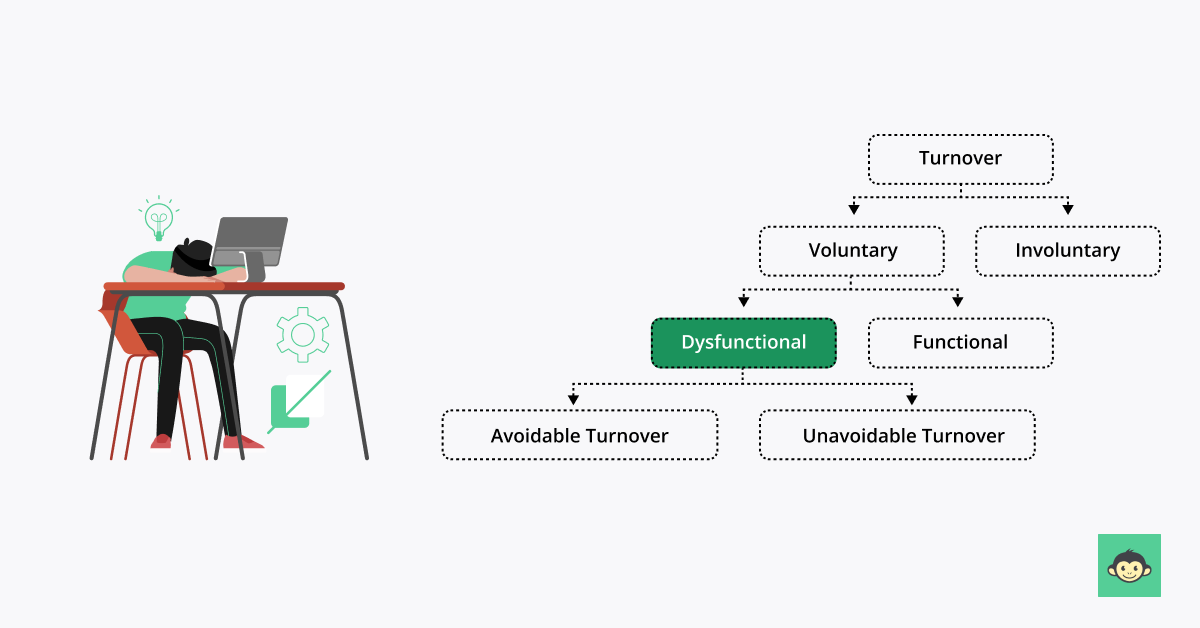Employee turnover: Definition, causes, and strategies to improve them

Just like a beautifully crafted cake, a thriving workplace is made up of many layers, each one adding its unique flavor and texture. But what happens when one of those layers decides to crumble and leave the rest of the cake feeling a little less sweet? Well, that's what we're here to talk about today.
Now, imagine this: you've spent hours perfecting your recipe for success. You've hired talented individuals, trained them to be your organization's best, and created a workplace culture that's as inviting as the aroma of freshly baked goodies. But here's the harsh reality—employee turnover can be the sneaky cherry on top that sabotages your efforts.
But fret not! With the right techniques, you can combat turnover by incorporating the right feedback tools. That's where employee engagement software comes in, serving as the secret ingredient to keep your team's enthusiasm and loyalty intact.
So grab your pens and notepads because we're about to unlock the secrets to a happy, thriving workforce.
Table of contents:-
- What is employee turnover?
- Is employee turnover good or bad?
- What are four types of employee turnover?
- What is dysfunctional turnover?
- What is voluntary turnover?
- What is involuntary turnover?
- Voluntary turnover vs involuntary turnover
- What is the difference between functional turnover and dysfunctional turnover?
- What is unavoidable turnover?
- What is the root cause of turnover?
- High employee turnover statistics that you should know
- What does poor turnover mean?
- What is the main cause of employee turnover?
- How dysfunctional turnover disrupts your organization?
- How to calculate employee turnover?
- How to reduce employee turnover?
- How to reduce dysfunctional turnover?
- How can businesses predict employee turnover?
- Employee turnover trends
- How does high employee turnover affect business performance?
- What is a healthy employee turnover rate?
- The cost of employee turnover rate
- How to prevent employee turnover?
- How can an employee retention software like CultureMonkey help you curb employee turnover?
What is employee turnover?

Employee turnover refers to the rate at which employees leave an organization and must be replaced. You know, that moment when you thought you had the perfect combination of flavors, but one unexpectedly disappears, leaving a noticeable gap in the overall taste? Yeah, that's turnover for you.
Now, turnover can be a bit of a double-edged sword. On the one hand, a little bit of movement in the workplace can bring in fresh perspectives and ideas, just like adding a dash of zest to a recipe.
But on the other hand, excessive turnover can disrupt the harmony of your team, like trying to bake a cake with a revolving door instead of an oven. Not exactly a recipe for success, is it?
Here's the thing: while a little bit of turnover is inevitable, excessive turnover can leave a bitter aftertaste. It can lead to decreased productivity, increased costs, and a general sense of unease within the workplace.
Is employee turnover good or bad?

Ah, the age-old question: is employee turnover a delectable delight or a bitter pill to swallow? Well, the answer lies somewhere in between, just like finding the perfect balance of sweetness in a cake. So, let's slice into this debate and have ourselves a little taste test!
Now, on the one hand, turnover can be seen as a positive ingredient in the workplace recipe. Just like adding a pinch of spice to a dish, a healthy level of turnover can bring in fresh perspectives, new skills, and innovative ideas. It allows for the continuous flow of talent, keeping your organization adaptable and vibrant.
But excessive turnover can disrupt team dynamics, lead to a loss of institutional knowledge, and create instability within your organization. It's like having too much of a good thing, resulting in an unbalanced flavor profile.
So, employee engagement's the secret ingredient to finding the right balance. When your team members are fully engaged, they're more likely to stick around. Engaged employees feel valued, motivated, and connected to the organization's mission, reducing the desire to seek greener pastures.
What are four types of employee turnover?

Let's dig deeper into the scrumptious world of employee turnover. Here are four types of turnover that can make or break your workplace culture:
Voluntary turnover
Picture this—a slice of cake that decides to jump off the plate and onto the dessert table at the party next door. Similarly, voluntary turnover occurs when employees willingly leave your organization due to better opportunities, career growth, or a change in their life recipe.
Involuntary turnover
Involuntary turnover happens when employees are asked to leave against their wishes, usually due to poor performance, misconduct, or organizational restructuring.
Functional turnover
It's when employees who aren't a good fit for their roles or the organization decide to pack their bags voluntarily. It's like a flavor that doesn't mesh well with the cake experience.
Dysfunctional turnover
Dysfunctional turnover refers to the loss of top-performing and highly skilled employees, leaving a void that's hard to fill.
But why does understanding these different types of turnover matter? Well, knowing the types of turnover can help you address them proactively.
What is dysfunctional turnover?

Dysfunctional turnover, within the context of organizational dynamics, refers to the departure of employees whose exit negatively impacts the company's performance, culture, or overall effectiveness. Unlike voluntary turnover prompted by natural career progression or personal choices, dysfunctional turnover is marked by its detrimental consequences.
The origins of dysfunctional turnover often trace back to a misalignment between employee expectations and organizational realities. This misalignment can manifest in various ways, such as insufficient communication, inadequate career development opportunities, or a lack of recognition for contributions. When employees feel disengaged or undervalued, the seeds of dysfunctional turnover are sown.
High rates of dysfunctional turnover can indicate systemic issues within an organization. This may include ineffective leadership, a toxic work environment, or a failure to address employee concerns. The cost of dysfunctional turnover extends beyond the immediate loss of talent, encompassing recruitment expenses, training investments, and potential disruptions to team cohesion.
Identifying dysfunctional turnover requires a thorough analysis of departure patterns and employee feedback. Exit interviews, surveys, and performance metrics can provide valuable insights into the underlying causes.
Addressing dysfunctional turnover demands proactive measures, such as refining leadership practices, enhancing communication channels, and fostering a workplace culture that values and supports its workforce.
What is voluntary turnover?
Voluntary turnover, within the organizational context, refers to the deliberate departure of employees from their positions by choice. Unlike involuntary turnover, which results from circumstances beyond an employee's control, voluntary turnover is initiated at the discretion of the individual.
There are various reasons that may prompt voluntary turnover. Career advancement, pursuit of personal goals, or the desire for a more conducive work environment are common drivers. Employees may also choose to leave due to dissatisfaction with aspects such as compensation, job responsibilities, or organizational culture.
Monitoring and understanding voluntary turnover is crucial for organizations aiming to maintain a stable and engaged workforce. High rates of voluntary turnover can signify underlying issues within the workplace, including dissatisfaction, limited growth opportunities, or inadequate recognition of employee contributions.
Conducting exit interviews, surveys, and analyzing employee feedback can aid in comprehending the factors influencing voluntary turnover.
Organizations can use this information to implement strategic measures, such as enhancing employee benefits, refining leadership practices, and providing avenues for professional development, to mitigate the likelihood of valued employees choosing to depart.
What is involuntary turnover?
Involuntary turnover, in the organizational context, pertains to the termination or separation of employees initiated by the employer, typically due to factors beyond the employee's control. This can include, but is not limited to, performance issues, restructuring, economic downturns, or organizational realignment.
Employers may resort to involuntary turnover when an employee's performance consistently falls short of expectations, impacting the overall efficiency and productivity of the team or organization. Structural changes, mergers, or financial constraints may also necessitate the reduction of workforce through involuntary means.
Understanding and managing involuntary turnover is integral for organizational success. It demands a judicious approach, incorporating fair and transparent processes. Clear communication regarding the reasons for involuntary turnover can help mitigate potential negative impacts on employee morale and the broader workplace culture.
To navigate involuntary turnover effectively, organizations should establish performance management systems, provide adequate training and support, and, when possible, offer alternative solutions such as reassignment or upskilling to align with evolving organizational needs.
Balancing the exigencies of the business with a compassionate and ethical approach to employee transitions is vital for sustaining a positive workplace environment even amid periods of change.
Voluntary turnover vs involuntary turnover

Voluntary turnover occurs when employees willingly choose to leave your organization. It can be due to various reasons—seeking better opportunities, career growth, or a change in personal circumstances. It's like a flavorful ingredient that decides to explore other culinary adventures.
On the other side of the mixing bowl, we have involuntary turnover. It happens when employees are asked to leave against their wishes. It can occur due to poor performance, misconduct, or organizational restructuring. It's like an unexpected twist that disrupts the cake's original recipe.
Now, you might wonder, which type of turnover is more detrimental to your workplace? Well, the answer lies in the proportion and impact of each ingredient.
While voluntary turnover can sometimes bring positive change, too much of it can lead to instability and a loss of valuable talent. Similarly, excessive involuntary turnover can create an atmosphere of fear and uncertainty, leaving a bitter aftertaste.
By nurturing a positive work environment, providing growth opportunities, and recognizing employee contributions, you can reduce voluntary turnover. And when it comes to involuntary turnover, invest in performance management, clear communication, and fair practices to minimize its impact.
What is the difference between functional turnover and dysfunctional turnover?
Employee turnover, a natural facet of organizational dynamics, can be categorized into two primary forms: functional turnover and dysfunctional turnover. While both involve the departure of employees, the impact and underlying reasons for each differ significantly.
Let's dissect the key distinctions between functional turnover and its disruptive counterpart, dysfunctional turnover.
Voluntary nature
- Functional turnover: In functional turnover, employees voluntarily choose to leave the organization for reasons aligned with their personal and professional growth. This can include pursuing higher education, career changes, or retirement.
- Dysfunctional turnover: Conversely, dysfunctional turnover occurs when employees exit the organization due to factors that negatively impact the workplace, such as poor management, inadequate work conditions, or limited growth opportunities.
Impact on organizational goals:
- Functional turnover: While functional turnover involves the loss of talent, it is perceived as a natural and often positive part of organizational evolution. Employees departing for career advancements contribute to a talent pool, potentially enhancing the organization's external network.
- Dysfunctional turnover: Dysfunctional turnover, on the other hand, disrupts organizational goals. The departure of employees under negative circumstances can lead to a decline in productivity, increased recruitment costs, and challenges in achieving strategic objectives.
Nature of employee contributions
- Functional turnover: Employees engaging in functional turnover may have made significant contributions during their tenure. Their departure is typically marked by a sense of accomplishment, as they move on to new challenges or stages in their careers.
- Dysfunctional turnover: In dysfunctional turnover, departing employees may leave behind unfulfilled potential and unresolved issues. Their exit might underscore underlying problems within the organization that need attention.
Organizational adaptability
- Functional turnover: Organizations that adapt positively to the departure of employees in functional turnover demonstrate resilience and a commitment to supporting individual career growth.
- Dysfunctional turnover: Dysfunctional turnover underscores organizational challenges in adapting to employee needs, potentially signaling deeper issues in leadership or workplace culture.
Employee morale
- Functional turnover: Well-managed functional turnover, with transparent communication and support for departing employees, can maintain or even enhance employee morale.
- Dysfunctional turnover: Dysfunctional turnover, especially if perceived as unfair or avoidable, can significantly dampen morale among remaining staff, leading to disengagement and reduced productivity.
Cost implications
- Functional turnover: While there are costs associated with functional turnover, such as recruitment expenses, the long-term benefits of attracting fresh talent may outweigh these initial investments.
- Dysfunctional turnover: Dysfunctional turnover incurs substantial costs, including recruitment, training, and potential productivity losses, amplifying the financial burden on the organization.
Frequency and patterns
- Functional turnover: Functional turnover tends to follow natural career progressions, with employees leaving at different stages in their professional journeys.
- Dysfunctional turnover: Dysfunctional turnover may occur unexpectedly, with patterns emerging due to systemic issues within the organization that need prompt attention.
Employee perception
- Functional turnover: Employees often perceive functional turnover as a positive aspect of career development, signaling a workplace that supports individual growth.
- Dysfunctional turnover: Dysfunctional turnover can breed skepticism and mistrust among employees, questioning the organization's commitment to their well-being and professional fulfillment.
What is unavoidable turnover?

Unavoidable turnover within an organizational context refers to the separation of employees from their positions due to circumstances beyond the control of both the employer and the employee.
Unlike voluntary turnover, which is initiated by the employee's choice, and involuntary turnover, which results from employer-driven decisions, unavoidable turnover is a consequence of external factors that render continued employment impractical or unfeasible.
Common triggers for unavoidable turnover include personal circumstances such as health issues, relocation, or changes in family dynamics. Additionally, economic downturns, industry shifts, or force majeure events can contribute to the inevitability of employee separation.
Organizations must recognize and manage unavoidable turnover with empathy and flexibility. Establishing supportive policies, such as compassionate leave or remote work options when possible, can help employees facing personal challenges.
In cases where external factors impact the organization's ability to maintain certain roles, proactive communication and assistance in transition planning become crucial.
Acknowledging and navigating unavoidable turnover with sensitivity reinforces an organization's commitment to the well-being of its workforce. While the organization may not control the external factors prompting turnover, it can control the manner in which it responds, striving to uphold a compassionate and understanding approach in these unavoidable circumstances.
What is the root cause of turnover?

The root causes of turnover within an organizational context are multifaceted, encompassing a myriad of factors that collectively influence the decision of employees to stay or leave. One primary determinant is the alignment, or lack thereof, between individual expectations and organizational realities.
When employees perceive a dissonance in their career goals, work environment, or the recognition of their contributions, it can serve as a catalyst for turnover.
Inadequate leadership and management practices also stand as prominent contributors. Poor communication, insufficient support, and a lack of opportunities for professional development can erode employee satisfaction and engagement, fostering an environment conducive to turnover. Moreover, organizational culture plays a pivotal role; a toxic or uncollaborative atmosphere can prompt valued employees to seek alternative work environments.
Compensation and benefits, while not the sole determinants, significantly impact the decision-making process. Disparities between employee expectations and the actual compensation structure can prompt attrition.
Effective identification of the root causes of turnover necessitates comprehensive analyses, including exit interviews, surveys, and ongoing feedback mechanisms.
Organizations must proactively address these underlying factors, implementing strategic measures such as leadership development programs, transparent communication channels, and competitive compensation packages to mitigate turnover and foster a workplace conducive to long-term employee retention.
High employee turnover statistics that you should know

- Total separations rate in 2021: The Bureau of Labor Statistics reports a total separations rate of 47.2% for U.S. jobs in the year 2021. (Source: Bureau of Labor Statistics)
- Jobless quitting trends in 2021: According to McKinsey, 36% of employees who quit within a six-month period in 2021 did so without having a new job lined up. Additionally, in the same survey, 64% of employees likely to quit within the next six months indicated they would do so without securing a new job. (Source: McKinsey)
- Doubling of voluntary turnover in a decade: Work Institute notes that the voluntary turnover rate for U.S. employees doubled over a ten-year period, surging from approximately 25 million quits in 2011 to almost 50 million quits in 2021. (Source: Work Institute)
- Monthly employee quit rate in 2022: In 2022, a staggering 50.6 million U.S. employees voluntarily quit their jobs, averaging 4.2 million resignations each month. (Source: Bureau of Labor Statistics)
- Impact of engagement on turnover: Gallup reveals that low-engagement teams experience turnover rates ranging from 18% to 43% higher than highly engaged teams. (Source: Gallup)
- The role of empathetic leadership: EY Consulting's survey highlights that 79% of respondents factor empathetic leadership into decisions to stay at a company. Additionally, 88% believe that empathetic leadership fosters loyalty among employees toward their leaders. (Source: EY)
What does poor turnover mean?
Poor turnover, within the organizational context, signifies a situation where an entity experiences a higher-than-desirable rate of employee departures. It is indicative of challenges in talent retention and may be symptomatic of underlying issues within the organizational structure, culture, or management practices.
High turnover rates can lead to a range of detrimental consequences, including increased recruitment costs, disruptions in workflow, and a negative impact on team morale.
When turnover is deemed poor, it implies that the organization is grappling with difficulties in retaining skilled and experienced personnel, which can impede the continuity of operations and hinder the pursuit of strategic objectives.
This phenomenon is often associated with factors such as inadequate leadership, unsatisfactory working conditions, limited growth opportunities, or a lack of employee engagement initiatives.
What is the main cause of employee turnover?

Ah, my inquisitive readers, the quest to uncover the main cause of employee turnover is like searching for that one elusive ingredient that throws off the entire cake recipe. So, let's put on our detective hats and follow the breadcrumbs to find the culprit behind this mystery!
There isn't just one single cause of turnover that we can blame entirely. It's more like a combination of flavors that can vary from organization to organization. However, if we were to identify a common thread that runs through many cases of turnover, it would be a lack of employee engagement. Ah-ha!
Employees can feel disengaged when disconnected from their work, the organization, or colleagues. It's like having a missing ingredient that leaves the whole cake feeling flat.
So, how can we address this? It all comes down to creating a culture that fosters employee engagement.
Just as a master baker carefully selects the finest ingredients, you must invest in meaningful employee experiences, offer growth opportunities, and provide a supportive work environment. Remember, engaged employees are like the secret sauce that adds flavor and depth to your organization.
Furthermore, leveraging employee engagement software can help you identify and tackle the underlying causes of disengagement. It's like having a trusty kitchen scale to measure the right proportions of ingredients. You can enhance engagement and reduce turnover by tracking metrics, collecting feedback, and implementing targeted strategies.
Now, let's not forget that while employee engagement plays a significant role, there can be other contributing factors to turnover—such as inadequate compensation, lack of recognition, or limited career growth.
How dysfunctional turnover disrupts your organization?

Employee turnover is an inevitable aspect of organizational dynamics, but when it takes on a dysfunctional form, the repercussions can be profound and far-reaching.
Dysfunctional turnover, characterized by the departure of employees whose exit negatively impacts the company, is a disruptive force that can impede productivity, hinder team dynamics, and undermine the overall success of an organization.
Let's delve into the specifics of how dysfunctional turnover can create turbulence within your organizational framework.
- Diminished productivity: Dysfunctional turnover often leads to a loss of institutional knowledge and expertise. When seasoned employees with valuable skills and insights depart, the remaining team members may struggle to compensate for the knowledge gap, resulting in diminished overall productivity.
- Increased workload for remaining staff: The abrupt departure of employees can leave the remaining staff burdened with additional responsibilities. This increased workload not only elevates stress levels but also jeopardizes the quality of work as employees contend with the challenge of managing tasks that were not originally within their purview.
- Negative impact on team morale: Dysfunctional turnover can cast a shadow on team morale. The departure of colleagues, especially if it is perceived as unjust or avoidable, can breed discontent and a sense of insecurity among the remaining workforce, leading to a decline in overall team morale.
- Disruption in project continuity: Ongoing projects often rely on the collaboration and knowledge of multiple team members. Dysfunctional turnover can disrupt the continuity of projects, causing delays, rework, and potential setbacks in achieving project milestones.
- Erosion of organizational culture: Employee departures, particularly when frequent or unexpected, can erode the fabric of organizational culture. The sense of stability and continuity that a strong culture provides is jeopardized when turnover becomes dysfunctional, impacting employee engagement and loyalty.
- Attrition of institutional knowledge: Dysfunctional turnover results in the loss of institutional knowledge accumulated by departing employees. This tacit knowledge, often gained through experience and tenure, is challenging to replace and can significantly hinder the organization's ability to navigate challenges and make informed decisions.
- Strategic misalignment: When turnover is dysfunctional, it may indicate a misalignment between organizational strategies and the expectations and experiences of employees. This misalignment not only contributes to turnover but can also impede the successful execution of strategic initiatives.
How to calculate employee turnover?

Calculating turnover requires a pinch of precision and a dash of data. Let's get cooking!
To start, we need two key data: the number of employees who left during a specific period and the average number of employees during that same period.
Now, grab your calculator and divide the number of employees who left by the average number of employees. Multiply the result by 100 to get the turnover percentage. Voila! You've calculated employee turnover.
Example:
Employee turnover rate = (Number of employees who left / Average number of employees) * 100
Beginning number of employees = 100
Employees who left = 20
New hires = 10
Average number of employees = (100 + 90) / 2 = 95
Employee turnover rate = (20 / 95) * 100 ≈ 21.05%
But hold your spatulas, folks! We're not done yet. It's essential to analyze turnover data further to understand the reasons behind it. Is it voluntary or involuntary? Are there patterns among certain departments or positions? Analyzing turnover data helps you identify trends and take proactive steps to reduce turnover.
How to reduce employee turnover?

Reducing turnover requires a blend of ingredients and a sprinkle of strategic thinking. Let's get cooking!
Create a nurturing culture
Just as a warm and inviting atmosphere makes people want to linger, a nurturing culture keeps employees engaged and committed. Foster open communication, provide opportunities for growth, and promote work-life balance. A culture that values and supports its employees is the secret sauce for reducing turnover.
Enhance employee engagement
Remember the importance of engagement we highlighted earlier? Well, it's time to give it a generous helping. Actively involve employees in decision-making, recognize their contributions, and foster a sense of belonging.
Offer competitive compensation and benefits
Employees need competitive compensation and benefits to stay satisfied. Conduct regular salary reviews, offer performance-based incentives, and provide comprehensive benefits packages. Show your employees they're valued, and they'll be less tempted by offers from other organizations.
Provide opportunities for development
Employees crave opportunities to grow and develop like a cake that rises to new heights. Offer training programs, mentorship initiatives, and clear career paths. By investing in their professional growth, you'll create a workforce that's motivated to stay and reach new heights within your organization.
Improve leadership and management
Effective leadership and management play a crucial role in reducing turnover. Train managers to be supportive, provide and collect regular feedback, and foster positive relationships with their teams. A strong leadership foundation creates an environment where employees feel valued and supported.
Conduct stay interviews
Conducting stay interviews allows you to understand what keeps employees committed. Regularly check in with employees to gather feedback, address concerns, and identify areas for improvement. It's like adding a touch of personalization to your retention efforts.
Embrace flexibility
Embrace flexible work arrangements, remote work options, and a healthy work-life balance. You'll create an environment that supports their personal and professional well-being by accommodating their needs.
Foster a positive work environment
A positive work environment lifts spirits and creates a sense of belonging. Encourage teamwork, celebrate achievements. Employees who enjoy coming to work are less likely to seek opportunities elsewhere.
How to reduce dysfunctional turnover?

Dysfunctional turnover – the unwelcome guest in any organization's party. When valued employees start heading for the exit, it's not just a departure; it's a red flag. But fear not, because there are ways to turn the tide and keep your A-team intact.
Let's dive into some strategies to reduce dysfunctional turnover and create a workplace where people want to stay.
- Open the lines of communication: Foster a culture where employees feel comfortable expressing their concerns. Open channels of communication allow for early identification of issues that could otherwise contribute to dysfunctional turnover.
- Provide career development opportunities: Employees crave growth. Offer training, mentorship programs, and pathways for career progression. When individuals see a future within the organization, they're more inclined to stick around.
- Enhance recognition and rewards: Acknowledge and celebrate achievements. Feeling valued goes a long way in keeping employees engaged. Implementing a robust recognition and rewards system can be a powerful tool against dysfunctional turnover.
- Create a positive work environment: The vibe matters. Foster a positive and inclusive work environment. Employees are more likely to stay in a workplace where they feel valued, respected, and part of a collaborative team.
- Implement employee assistance programs: Personal challenges can spill into the professional realm. Implement employee assistance programs to provide support for mental health, work-life balance, and overall well-being.
- Address systemic issues: Tackle the root causes. If dysfunctional turnover is recurrent, address systemic issues such as poor management practices, unclear career paths, or a toxic culture.
- Encourage work-life balance: Burnout is a dysfunctional turnover accomplice. Encourage a healthy work-life balance by setting reasonable expectations and discouraging a 'workaholic' culture.
How can businesses predict employee turnover?

Here are ways businesses can employ strategies to forecast and address potential turnover:
Analyze historical data
Businesses can analyze historical data to identify patterns and trends. Look at past turnover rates, reasons for departures, and any commonalities among employees who have left. This helps to uncover insights that can inform predictive strategies.
Conduct employee surveys
Conduct anonymous surveys to gauge employee satisfaction, engagement, and intentions to stay. Ask about their perceptions of the workplace, opportunities for growth, and overall job satisfaction. This anonymous feedback acts as a magic mirror, reflecting potential turnover risks.
Keep an eye on key indicators
Businesses must keep an eye on key indicators that may signal potential turnover. High absenteeism, decreased productivity, or a surge in employee complaints can be warning signs. By being attuned to these indicators, businesses can take proactive measures to prevent turnover.
Use predictive analytics
Predictive analytics can help forecast employee turnover by analyzing various data points. By leveraging sophisticated algorithms, businesses can identify at-risk employees, factors contributing to turnover and even predict when employees may consider leaving. It's like having a crystal ball that provides insights into the future.
Monitor competitor landscape
Stay informed about industry trends, job market conditions, and what competitors offer regarding benefits, perks, and growth opportunities. This knowledge helps businesses stay competitive and retain their top talent.
Employee turnover trends

Just as a roller coaster has its ups and downs, the world of talent retention is no different. So, hold on tight as we explore some fascinating statistics and trends that can help you navigate this exhilarating journey.
The Great Resignation: The employment landscape has recently witnessed a phenomenon known as "The Great Resignation." Employees, fueled by a desire for change and reevaluation of work-life balance, are leaving their jobs in record numbers.
According to a survey conducted by Microsoft, a staggering 41% of global workers are considering leaving their current employers within the next year.
Generational Shifts: Just as different roller coaster sections offer unique experiences, each generation brings its own perspective to the workforce. Baby boomers are retiring, making way for millennials and Gen Z to dominate the talent pool.
These younger generations seek meaningful work, career development, and positive company culture. According to Gallup, 21% of millennials say they've changed jobs within the past year, and 60% are open to new job opportunities (Source: Gallup, How Millennials Want to Work and Live).
These statistics paint a vivid picture of the current employee turnover landscape, urging businesses to adapt and embrace strategies that appeal to evolving employee expectations.
From navigating the wave of resignations to catering to the unique needs of different generations, understanding these trends is key to staying ahead of the curve.
How does high employee turnover affect business performance?

High turnover can profoundly impact an organization's success. So, grab your aprons, and let's uncover how turnover impacts business performance.
Costly concoction
High employee turnover can be a costly affair for businesses. From recruitment and onboarding expenses to training and lost productivity. According to the Society for Human Resource Management (SHRM), the cost of replacing an employee can range from 50% to 200% of their annual salary. That's quite a dent in the budget!
Disruption
Constantly training new hires and bringing them up to speed takes valuable time and resources away from core activities. It can lead to decreased productivity, lower team morale, and a strained work environment.
Customer satisfaction suffers
A team of experienced and engaged employees creates exceptional customer experiences. On the other hand, high turnover can leave customers with a bitter aftertaste. With new faces appearing regularly, customers may feel a lack of continuity and personal connection, impacting their satisfaction and loyalty.
Drain on knowledge and expertise
Experienced employees hold valuable knowledge and expertise. High turnover erodes this institutional knowledge, leaving the organization at a disadvantage. Losing seasoned employees means losing their insights, skills, and ability to mentor others—a significant blow to business performance.
Recipe for low employee morale
Just as a cake falls flat without the right leavening agent, high turnover can deflate employee morale. Witnessing colleagues leave can create uncertainty and dissatisfaction among the remaining team members. Low morale affects motivation, teamwork, and overall employee engagement, hindering business performance.
Strained reputation
A business plagued by high turnover may struggle to attract and retain top talent. Word travels fast in the professional world, and a reputation for frequent turnover can deter qualified candidates from joining the organization. This can limit the pool of talent and hinder the company's growth potential.
Increased workload and stress
A surge in employee turnover often results in an increased workload for the remaining staff. The added responsibilities can lead to higher stress levels, affecting both individual well-being and overall team dynamics. As employees grapple with heightened work demands, burnout becomes a looming threat, further compromising business performance.
Impact on team collaboration
Team cohesion is vital for achieving collective goals. High employee turnover disrupts the natural rhythm of collaboration as new team members continuously integrate. This constant influx can hinder effective communication, impede trust-building, and create challenges in fostering a cohesive and harmonious working environment.
Training investment goes down the drain
Investing in the training and development of employees is a strategic move. However, when high turnover rates persist, the resources allocated to training can seem like a wasted investment. As new hires leave shortly after training, the organization may find itself with a diminished return on its training expenditure.
Extended time-to-productivity
Bringing a new employee up to speed is an investment in time and resources. High turnover elongates the time-to-productivity for the workforce as a whole. Constantly acclimating new hires delays the attainment of optimal efficiency, slowing down business processes and hindering the achievement of performance milestones.
What is a healthy employee turnover rate?

A healthy turnover rate refers to the optimal level of employee departures that promotes organizational growth while still maintaining a stable and engaged workforce. While there isn't a one-size-fits-all answer, here are some pointers to help you find your organization's unique sweet spot:
Context is the key
Like adjusting seasoning to suit different tastes, the ideal turnover rate varies based on industry, job roles, and organizational goals. Some industries, such as retail and hospitality, tend to have higher turnover rates due to the nature of the work. It's essential to consider the broader context before determining what's healthy for your specific situation.
Retention vs. innovation
A healthy turnover rate strikes a balance between retaining valuable employees and introducing new voices that can drive innovation and growth. Too low of a turnover rate may lead to stagnation, while too high can create instability.
Benchmarking for balance
Just as comparing your dish to industry standards helps gauge its quality, benchmarking against similar organizations can provide insights into what's considered a healthy turnover.
Research industry-specific turnover rates and compare them to your own to gain perspective. This can help you assess if your turnover rate is within a healthy range.
Focus on retention strategies
Like adding a dash of extra care to retain the flavor in a dish and investing in retention strategies can help maintain a healthy turnover rate. Focus on creating a positive work culture, providing growth opportunities, and recognizing employee achievements. By nurturing your existing talent, you can reduce the need for excessive turnover.
Analyze employee feedback
Just as tasting feedback helps refine a recipe, listening to employee feedback can provide valuable insights into turnover concerns. Conduct exit interviews and stay interviews to understand the reasons behind departures and gather feedback from current employees. This information can guide your efforts in maintaining a healthy turnover rate.
Industry dynamics and geographical variations
Consider the nuances of your industry and geographical location. Industries with high competition or specific talent demands may naturally experience higher turnover. Additionally, regional job markets and cultural factors can influence turnover rates. Understanding these dynamics ensures a more accurate assessment of what constitutes a healthy turnover rate in your context.
Adaptability to technological changes
In today's rapidly evolving business landscape, adaptability to technological advancements is crucial. A healthy turnover rate should accommodate the need for employees who can swiftly embrace new technologies. This adaptability ensures that your workforce remains competitive and capable of navigating the evolving demands of the digital era.
Demographic considerations
Demographic shifts within the workforce can impact turnover rates. For instance, different age groups may have distinct career expectations and job preferences. A healthy turnover rate takes into account these demographic considerations, acknowledging the need for flexibility in employment strategies tailored to diverse workforce segments.
The cost of employee turnover rate

Just as a lavish feast can come with a hefty bill, high turnover rates can leave a dent in an organization's financial coffers. So, let's grab our calculators and delve into the world of costs that come with employee departures!
Recruitment and onboarding expenses
The recruitment and onboarding process can add flavor to an organization. However, the cost of sourcing, screening, interviewing, and hiring new employees can be quite substantial. Advertising job postings, conducting background checks, and investing in training programs all contribute to the bill.
Productivity loss
Like a leaky faucet that wastes water, high turnover can result in a significant loss of productivity. When employees leave, there's a gap in knowledge, skills, and experience that needs to be filled. New hires take time to get up to speed and reach their full potential, leading to a temporary decrease in productivity and output.
Training and development investment
When employees depart, the investment made in their development goes to waste. The cost of training new hires to reach the same level of proficiency adds another layer to the bill.
Customer impact
Like a dissatisfied diner who never returns, high turnover rates can impact customer relationships. Building rapport and trust with customers takes time and effort. When key employees leave, relationships may suffer, and customer satisfaction and loyalty may decline. This can lead to lost business opportunities and a negative impact on revenue.
Company culture and morale
High turnover can disrupt the harmony within an organization, impacting the overall culture and leaving remaining employees feeling demoralized and uncertain. This can lead to decreased motivation and decreased productivity across the board.
Extended recruitment timelines
A prolonged recruitment process is an additional cost of high turnover. The longer it takes to fill a vacant position, the more strain it puts on existing staff who may need to cover the workload. Extended timelines can result in productivity losses and increased workload for the team.
Overhead costs
Beyond direct recruitment expenses, overhead costs associated with high turnover include administrative expenses for processing terminations, exit interviews, and managing documentation. These seemingly minor costs collectively contribute to the overall financial impact of employee turnover.
Impact on innovation and creativity
Constant turnover disrupts the synergy within a team, impacting collaborative efforts and stifling innovation. A workforce in a state of flux may struggle to cultivate a culture of creativity and forward-thinking. The long-term cost involves missed opportunities for innovation and adaptation in a competitive business landscape.
Legal and compliance expenses
Employee turnover often involves legal and compliance considerations. Ensuring adherence to labor laws, handling severance packages, and managing potential legal disputes can escalate costs. Staying compliant during turnover transitions adds another layer of financial responsibility for organizations.
How to prevent employee turnover?

Just as a skilled magician knows the secrets behind their tricks, let's uncover the secrets to preventing employee departures and creating a harmonious work environment. Get ready to wield your retention wand and let the magic unfold.
Nurture a positive work culture
A positive work culture can work wonders in retaining employees. Foster a supportive and inclusive environment where employees feel valued and appreciated. Encourage open communication, recognize achievements, and create opportunities for growth and development. When employees feel connected and engaged, they're more likely to stay.
Provide competitive compensation and benefits
Providing competitive compensation and benefits is crucial for retention. Stay updated on industry standards and ensure your salary and benefits packages are attractive. Conduct regular market research to stay ahead of the curve and show employees that their hard work is rewarded.
Offer growth opportunities
Offering growth opportunities can keep employees engaged and committed. Provide clear career paths, mentorship programs, and opportunities for upskilling and professional development. Employees who see a future within the organization are more likely to stay and contribute their talents.
Foster work-life balance
Employees need a healthy work-life balance to thrive. Encourage flexible working arrangements, promote a culture of work-life balance, and offer wellness programs. Employees who feel supported in balancing their personal and professional lives are more likely to stay loyal.
Listen and act on feedback
Actively listen to your employees' feedback and concerns. Conduct regular employee engagement surveys, hold stay interviews, and create channels for open dialogue. Act on feedback, address issues and show employees that their voices are heard and valued.
How can an employee retention software like CultureMonkey help you curb employee turnover?
As we continue our quest to conquer employee turnover, it's time to uncover a powerful ally in our arsenal: employee retention software. Picture it as a trusty sidekick, ready to assist you in curbing turnover and creating a workplace that employees never want to leave.
One such software, CultureMonkey, holds the key to your retention success.
CultureMonkey offers a range of features to support your retention efforts. First, it allows you to conduct real-time pulse surveys to measure employee sentiment and engagement. By capturing feedback, you can identify areas for improvement and address concerns proactively.
The software provides actionable insights by analyzing survey data. These insights help you understand employee satisfaction and retention factors, empowering you to make informed decisions and implement targeted strategies.
CultureMonkey's engagement software helps you to foster a culture of recognition and growth, you create an environment where employees feel valued and motivated to stay.
The software also establishes seamless communication channels for employees to anonymously share their thoughts and concerns. This open dialogue builds trust and enables early issue detection, allowing you to address challenges before they become retention risks.
With CultureMonkey's retention analytics, you can comprehensively view turnover patterns and trends. Understanding the underlying causes of turnover enables you to tailor your retention strategies and implement targeted interventions.
Embrace the power of employee retention software like CultureMonkey to tame turnover and create a workplace where employees flourish.



